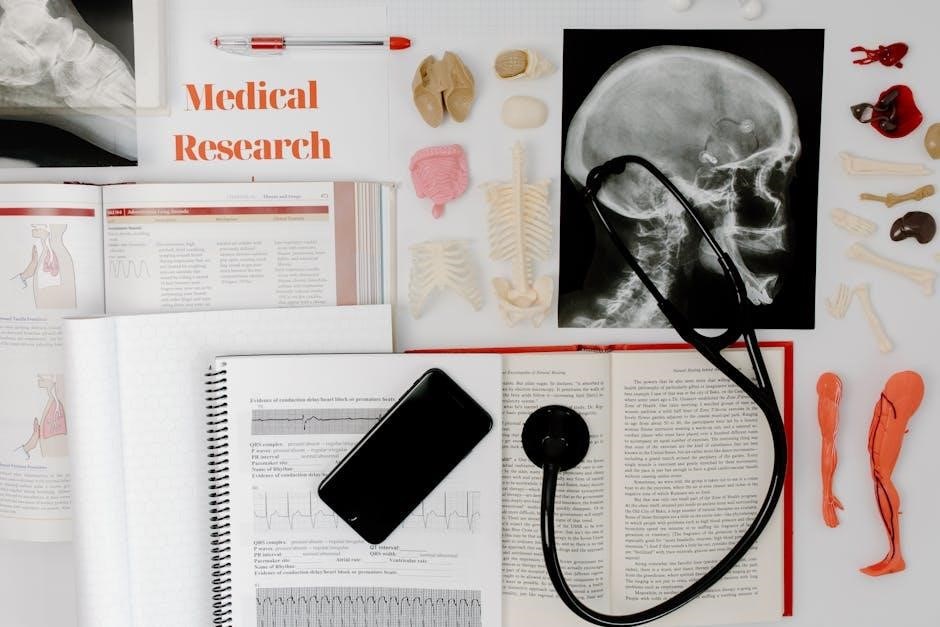The AP Chemistry exam is a rigorous assessment for high school students, offering college credit for mastery of foundational chemical principles and problem-solving skills. Study guides and practice exams are essential resources to prepare for this challenging test, ensuring a deep understanding of the curriculum and exam format.
Overview of the AP Chemistry Exam
The AP Chemistry exam is a comprehensive, 3-hour 15-minute assessment designed to evaluate students’ mastery of foundational chemical concepts and problem-solving skills. It consists of two sections: Section I includes 60 multiple-choice questions, and Section II comprises 7 free-response questions. The exam is evenly weighted, with each section contributing 50% to the total score. The content aligns with the College Board’s curriculum framework, emphasizing six big ideas in chemistry. Regular practice with official PDF study guides and past exams is crucial for understanding the exam format and improving performance. This structured approach ensures students are well-prepared for the challenges of the test.
Importance of the Exam for College Credit
Earning a strong score on the AP Chemistry exam can significantly impact a student’s academic trajectory. It allows students to demonstrate mastery of college-level chemistry, potentially earning them advanced placement or credit at participating universities. This not only accelerates their academic progress but also reduces the coursework required in college. Many institutions grant credit or placement based on exam performance, enabling students to enroll in higher-level courses sooner. Additionally, success on the exam highlights a student’s readiness for rigorous academic challenges, making them more competitive in college admissions. Thus, the AP Chemistry exam serves as a valuable opportunity to showcase skills and gain a head start in higher education.

Exam Format and Structure
The AP Chemistry exam consists of two sections: Section I (60 multiple-choice questions) and Section II (7 free-response questions). The total duration is 3 hours and 15 minutes.
Section I: Multiple-Choice Questions
Section I of the AP Chemistry exam features 60 multiple-choice questions, accounting for 50% of the total score. Students have 90 minutes to complete this section, with no calculator allowed. Questions cover a wide range of topics, from atomic structure to thermodynamics, and require both factual recall and analytical thinking. Strategies for success include eliminating incorrect answers, managing time effectively, and carefully reading each question. Practice with sample questions is crucial to build familiarity with the format and improve problem-solving speed. This section tests foundational knowledge and the ability to apply concepts under timed conditions, making preparation essential for achieving a high score.
Section II: Free-Response Questions
Section II of the AP Chemistry exam consists of 7 free-response questions, accounting for 50% of the total score. Students have 1 hour and 45 minutes to complete this section, which includes 3 long-answer questions and 4 shorter ones. This section assesses the ability to think critically, apply chemical concepts, and clearly communicate solutions. Questions may involve calculations, explanations of phenomena, or the analysis of experimental data. Graders evaluate both the accuracy of the answers and the clarity of the explanations. Practice with past exams and detailed review of mistakes are essential to excel in this section, as it requires precise and organized responses to complex chemical problems.
Time Allocation and Weightage
The AP Chemistry exam is 3 hours and 15 minutes long, divided into two sections with specific time allocations. Section I, containing 60 multiple-choice questions, lasts 90 minutes and accounts for 50% of the total score. Section II includes 7 free-response questions, completed in 105 minutes, also contributing 50%. The exam requires strategic time management to address all questions effectively. Proper allocation ensures students can demonstrate their understanding of chemical concepts without rushing. Balancing time between sections is crucial for achieving a high score, as both sections hold equal weight in the final grading. Efficient use of the allotted time is key to success.

Content Outline for the AP Chemistry Exam
The exam covers six Big Ideas: Atomic Structure, Molecular and Ionic Compounds, Chemical Reactions, Thermodynamics, Kinetics, and Equilibrium/Electrochemistry, forming the core of the curriculum.
Big Idea 1: Atomic Structure and Properties
Atomic structure and properties form the foundation of chemistry, focusing on the arrangement and behavior of electrons, protons, and neutrons. Key topics include electron configurations, quantum numbers, and periodic trends such as atomic radius and ionization energy. Understanding the periodic table’s structure and how atomic properties influence chemical behavior is crucial. Students explore the principles of wave-particle duality, Heisenberg uncertainty, and Schrödinger’s model to grasp electron distribution. Mastery of these concepts is essential for analyzing chemical reactions and bonding, as outlined in the AP Chemistry exam PDF study guides. Regular practice with problems involving electron configurations and periodic trends ensures a strong foundation for this section.
Big Idea 2: Molecular and Ionic Compounds
Big Idea 2 focuses on the composition and properties of molecular and ionic compounds. Students explore the formation of ionic and covalent bonds, molecular formulas, and Lewis structures. Key concepts include naming compounds, understanding molecular geometry, and analyzing solubility rules. The behavior of ionic compounds in aqueous solutions, such as dissociation and conductivity, is also emphasized. Mastery of molecular and ionic compounds requires practice in writing balanced equations, predicting solubility, and identifying chemical properties. These skills are crucial for success in the AP Chemistry exam, as highlighted in various PDF study guides and practice materials available online. Regular review of these topics ensures a solid understanding of chemical bonding and composition.
Big Idea 3: Chemical Reactions and Stoichiometry
Big Idea 3 delves into the principles of chemical reactions and stoichiometry, focusing on the quantitative relationships between reactants and products. Students learn to balance chemical equations, determine molar ratios, and calculate quantities such as moles, masses, and volumes. Key topics include limiting reagents, percent yield, and the stoichiometry of reactions involving gases; Understanding these concepts is crucial for solving problems in the AP Chemistry exam, as emphasized in PDF study guides. Practice problems and real-world applications help students master these calculations, ensuring they can apply stoichiometric principles to complex chemical scenarios effectively.
Big Idea 4: Thermodynamics

Big Idea 4 focuses on thermodynamics, exploring energy transformations and the principles governing them. Key concepts include the laws of thermodynamics, enthalpy, entropy, and Gibbs free energy. Students analyze how energy changes drive chemical processes and determine the spontaneity of reactions. Understanding thermodynamic systems, state functions, and the relationship between heat, work, and internal energy is essential. AP Chemistry exam PDF guides emphasize mastering these principles, as they are critical for solving problems involving chemical equilibrium and electrochemistry. Practice problems and real-world applications help reinforce these concepts, ensuring students can apply thermodynamic principles to predict and analyze reaction outcomes effectively.
Big Idea 5: Chemical Kinetics
Big Idea 5 delves into chemical kinetics, examining the rates of chemical reactions and the factors influencing them. Key concepts include reaction rate laws, catalysts, and the collision theory. Students learn to analyze experimental data to determine rate constants and identify reaction mechanisms. AP Chemistry exam PDF resources highlight the importance of understanding how concentration, temperature, and catalysts affect reaction rates. Mastering these principles is crucial for solving problems related to reaction kinetics and their applications in real-world scenarios. Practice questions and case studies in study guides help students apply these concepts effectively, ensuring a strong grasp of chemical kinetics for the exam.
Big Idea 6: Equilibrium and Electrochemistry
Big Idea 6 focuses on equilibrium and electrochemistry, foundational concepts in chemistry. Students explore equilibrium systems, including the equilibrium constant (K), Le Chatelier’s principle, and shifts in equilibrium. Electrochemistry topics cover redox reactions, electrochemical cells, and quantitative relationships like the Nernst equation. AP Chemistry exam PDF resources emphasize understanding how equilibrium and electrochemical principles apply to real-world phenomena. Practice problems and case studies in study guides help students master calculations and conceptual questions. This big idea is critical for analyzing chemical systems and their dynamic behavior, ensuring a solid understanding for exam success.

Study Resources for the AP Chemistry Exam
Official study guides, practice exams, and recommended textbooks provide comprehensive preparation for the AP Chemistry exam. Online platforms and PDF materials offer additional practice questions and in-depth explanations to ensure success.
Official Study Guides and Practice Exams
The College Board offers official study guides and practice exams tailored to the AP Chemistry exam. These resources include actual exam questions, providing students with a realistic preview of the test format and content. Additionally, they cover key concepts like atomic structure, thermodynamics, and chemical kinetics, ensuring a comprehensive review. Practice exams are particularly useful for time management and identifying weak areas. Many guides also include detailed explanations for correct and incorrect answers, helping students understand their mistakes and improve their performance effectively. Regular use of these resources can significantly enhance a student’s confidence and readiness for the exam.
Online Platforms for Practice Questions
Online platforms like Albert.io and Fiveable offer extensive libraries of AP Chemistry practice questions, designed to mimic the actual exam format. These resources provide personalized statistics, allowing students to track their progress and identify areas for improvement. Additionally, platforms like Khan Academy and Chegg offer interactive exercises and video tutorials to supplement practice. Many of these platforms are accessible anytime, making it easier for students to study consistently. They also include detailed explanations for both multiple-choice and free-response questions, helping students understand their mistakes and refine their problem-solving skills. These tools are invaluable for students aiming to master the AP Chemistry exam and achieve a high score.
Recommended Textbooks and PDF Materials
Several textbooks and PDF materials are highly recommended for AP Chemistry exam preparation. The College Board’s official study guides and released practice exams provide authentic question formats and content. Textbooks like “Chemistry: The Central Science” and “AP Chemistry: An Evolving Approach” offer comprehensive coverage of exam topics. Additionally, websites like Petersons and Simple Studies offer free downloadable PDF study guides that include detailed explanations and practice problems. These resources are invaluable for mastering concepts, understanding exam structures, and refining problem-solving skills. Utilizing these materials ensures a well-rounded preparation for the AP Chemistry exam.

Test-Taking Strategies
Effective strategies include time management, reading questions carefully, and prioritizing high-confidence answers first. Skilled test-takers eliminate incorrect options and organize free-response answers with clear equations and explanations.
Time Management During the Exam
Managing time effectively is crucial for success on the AP Chemistry exam. Allocate 90 minutes for Section I, which contains 60 multiple-choice questions, ensuring approximately 1.5 minutes per question. For Section II, with 7 free-response questions, distribute the 1 hour and 45 minutes wisely, spending about 15-20 minutes per question. Prioritize questions you’re confident about first to secure partial credit. Avoid spending too long on a single question, as this can jeopardize your ability to answer others. Practice under timed conditions to build stamina and refine your pacing strategy, ensuring you finish the exam calmly and confidently.

Techniques for Tackling Multiple-Choice Questions
Mastering multiple-choice questions on the AP Chemistry exam requires strategic approaches. Begin by eliminating clearly incorrect answers to narrow down options. Read each question carefully, focusing on keywords like “most likely” or “primary factor.” Use process of elimination and identify patterns in answer choices. Practice under timed conditions to enhance speed and accuracy. Reviewing practice exams and analyzing common question types can help you recognize recurring themes. Mnemonics and mental models can aid in recalling complex concepts quickly. Always balance speed with thoughtful consideration to avoid careless errors, ensuring you maximize your score in this section.
Approach to Free-Response Questions
Free-response questions on the AP Chemistry exam demand a thorough and structured approach. Begin by carefully reading the question to identify what is being asked. Outline your response before writing to ensure clarity and organization. Address each part of the question directly, using proper terminology and equations where necessary. For experimental-based questions, detail your observations and calculations step-by-step. Practice timing yourself to allocate 15-20 minutes per question. Highlight key terms and concepts to ensure readability. Always show your work, as partial credit is awarded for logical reasoning. Review your answers briefly before submitting to correct any errors or omissions.

Common Mistakes to Avoid
Common mistakes include poor time management, neglecting to read questions carefully, and calculation errors in the free-response section. Avoid these pitfalls to maximize your score.
Poor Time Management
Poor time management is a common pitfall during the AP Chemistry exam. Many students spend too much time on complex questions, leaving insufficient time for easier ones. This often results in incomplete answers, particularly in the free-response section, where partial credit is awarded. To avoid this, create a time budget: allocate specific minutes to each question based on its difficulty and weightage. Stick to your plan to ensure all questions are attempted. Running out of time can significantly lower your score, as unanswered questions earn no points. Effective time management is crucial for maximizing your potential and achieving a high score. Plan wisely and execute efficiently.
Neglecting to Read Questions Carefully
Neglecting to read questions carefully is a critical mistake that can lead to incorrect answers on the AP Chemistry exam. Rushing through questions often results in misinterpreting what is being asked, causing students to provide irrelevant or incomplete responses. This is particularly problematic in the free-response section, where points are awarded for both the approach and the final answer. To avoid this, take a moment to thoroughly read each question, identify key terms, and ensure your answer directly addresses what is being asked. Misreading questions can lead to wasted time and lost points, undermining your overall performance. Attention to detail is essential for success.

Calculation Errors in Free-Response Section
Calculation errors are a common pitfall in the free-response section of the AP Chemistry exam, often resulting from rushing or improper significant figure management. Students may correctly approach a problem but lose points due to arithmetic mistakes or misplacing decimals. To minimize these errors, practice consistent calculation techniques and double-check work. Utilize study resources like AP Chemistry PDF guides and practice exams to refine problem-solving skills and attention to detail. Regular review of mistakes can help identify patterns and improve accuracy. Ensuring calculations are clear and organized is crucial for earning full points in this section.

The Role of Practice in Success
Regular practice exams and review of mistakes are crucial for mastering the AP Chemistry exam. Utilize resources like PDF study guides and platforms offering personalized statistics to refine skills and build confidence in problem-solving abilities;
Importance of Regular Practice Exams
Regular practice exams are vital for achieving success on the AP Chemistry exam. They simulate real test conditions, helping students manage time effectively and reduce anxiety. By solving sample questions, students identify weak areas and strengthen their understanding of key concepts. Resources like PDF study guides and online platforms provide access to a variety of practice questions. These tools also offer detailed explanations and scoring metrics, enabling students to track their progress. Consistent practice fosters familiarity with the exam format and enhances problem-solving skills, ultimately leading to improved performance on test day.
Reviewing and Analyzing Mistakes
Reviewing and analyzing mistakes is a critical step in preparing for the AP Chemistry exam. By identifying error patterns, students can address weak areas and refine their understanding of complex concepts. Utilizing resources like PDF study guides and online platforms, students can track their progress and correct misconceptions. Detailed explanations in these materials help clarify common pitfalls, such as calculation errors or misapplying formulas. Regularly reviewing mistakes fosters a deeper grasp of topics like stoichiometry and thermodynamics, ensuring a more confident and accurate performance on exam day. This reflective process is essential for achieving a high score.
Seeking Help from Teachers or Tutors
Seeking help from teachers or tutors is a valuable strategy for excelling in the AP Chemistry exam. They provide personalized guidance, clarifying complex concepts and addressing individual weaknesses. Tutors can break down challenging topics, such as stoichiometry or thermodynamics, into manageable parts. Additionally, they offer insights into common exam pitfalls and strategies for tackling both multiple-choice and free-response questions. By leveraging their expertise, students can refine their problem-solving skills and gain confidence. Teachers and tutors often recommend PDF study guides and practice exams to reinforce learning. Their support ensures students are well-prepared for the exam’s demands, maximizing their potential for success.
Mastering the AP Chemistry exam requires dedication, strategic preparation, and utilizing resources like study guides and practice exams. Stay confident, focused, and thoroughly prepared to achieve success.
Final Tips for Achieving Success
To excel on the AP Chemistry exam, adopt a structured study plan using study guides and practice exams. Regularly review notes, focus on weak areas, and practice under timed conditions. Utilize online platforms like Albert.io for personalized practice and detailed feedback. Engage with PDF resources such as the 79-page study guide from Ebsco for clear explanations and examples. Stay organized, manage time effectively during the exam, and maintain a positive mindset. Seek help from teachers or tutors when needed. By combining consistent effort with strategic preparation, you can confidently achieve a high score and secure college credit.
Staying Confident and Prepared
Confidence and preparation are key to excelling on the AP Chemistry exam. Consistently review study guides and practice with PDF resources like the 79-page Ebsco guide. Use platforms such as Albert.io for personalized practice and feedback. Regularly test yourself with timed practice exams to build stamina and familiarity with the format. Focus on understanding concepts rather than memorizing formulas. Stay organized, seek help when needed, and maintain a positive mindset. By combining thorough preparation with self-belief, you can approach the exam with confidence and achieve your desired score. Remember, consistent effort leads to success.
